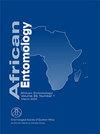南非外来入侵植物的病原菌和生物防治:项目和进展综述(2011-2020)
IF 1.2
4区 农林科学
Q3 ENTOMOLOGY
引用次数: 10
摘要
1991年、1999年和2011年审查了南非利用植物病原体对入侵外来植物进行生物控制(生物控制)的情况。在这篇综述中,详细介绍了2011年至2020年在使用外来病原体的经典制剂和使用本土病原体的淹没制剂方面的后续进展和项目。我们报告了在此期间监测的几种先前引入的外来真菌的影响。一个重要的亮点是,从1991年到2020年,完成了30年的年度监测,监测点记录了莫里斯尾枝藻Doungsa-ard、McTaggart、Geering和RG Shivas(Raveneliaceae)对唾液Acacia saligna(Labill.)Wendel(Fabaceae)密度的影响,下降幅度高达98%。释放后的监测还表明,当尖角藻(Regel)R.M.King和H.Rob(Astraceae)在南非的入侵范围仍然非常有限时引入的老年虫R.W.Barreto和H.C.Evans(钩虫科)阻止了这种杂草发挥其入侵者的潜力。Uromycladium woodii Doungsa ard,McTaggart,Geering&R.G.Shivas(Raveneliaceae。Prospordum transformans(Ellis&Everh。)Cummins(Raveneliaceae)未能在Tecoma stans(L.)Juss ex Kunth var.stans(Bignonaceae)上建立,同时努力释放兰塔普契尼。马鞭草科正在进行中。在已确定的作为经典生物防治剂的外来病原体中,有两种被认为对其目标杂草造成广泛损害,两种相当大的损害,以及两种中度损害。Puccinia are chavaletae Speg。(Pucciniaceae),一种在桔梗上建立的外来真菌。(Sapindaceae)的引入途径未知,被证明是一种破坏剂,并讨论了其在该国存在的影响。欧洲蒲草科(Puccinia eupatorii Dietel)在大角星(Campuloclinium macrochalum(Less.)DC上的早季扩增。(菊科)进行了测试,以确定损伤是否会增加,但在生长季节结束时,增强型和自然感染型植物之间的铁锈发生率和严重程度没有明显差异。注册为Stumpout®的本土真菌的身份,用于控制砍伐Acacia mearnsii De Wild后的矮林生长。(Fabaceae),被确认为Cylindrobasidium torrendii(Bres.)Hjortstam(Physalacriaceae),而不是之前认为的C.laeve(Pers.:Fr.)Chamuris。另一种本土真菌尖孢炭疽菌J.H.Simmonds(Glomerellaceae)通过直升机飞行的方式应用,促进了其在蚕桑Hakea sercea Schrad上的建立J.C.Wendl(蛋白质科),在人迹罕至的山区。出于注册目的,需要对这些本土真菌进行毒性测试(大鼠口服LD50)。torrendii Cylindrobasidium、C.acutatum和Pseudolagarobasidium acaciicola Gins(Phanerochaethaceae)的致死剂量,后者用于对抗Acacia cyclops G.Don。(Fabaceae),超过2000 mg kg–1体重,因此所有三种真菌都被认为是安全的。本文章由计算机程序翻译,如有差异,请以英文原文为准。
Plant Pathogens and Biological Control of Invasive Alien Plants in South Africa: A Review of Projects and Progress (2011–2020)
The use of plant pathogens for biological control (biocontrol) of invasive alien plants in South Africa was reviewed in 1991, 1999 and 2011. In this review, subsequent progress and projects undertaken in the years 2011 to 2020, on both classical agents using exotic pathogens and inundative agents using indigenous pathogens, are detailed. We report on the impact of several previously introduced exotic fungi, monitored during this period. A significant highlight is the completion of 30 years of annual monitoring, from 1991 until 2020, of the impact of Uromycladium morrisii Doungsa-ard, McTaggart, Geering & RG Shivas (Raveneliaceae) on the density of Acacia saligna (Labill.) Wendel (Fabaceae), with declines of up to 98% recorded at monitored sites. Post-release monitoring also suggested that Entyloma ageratinae R.W. Barreto & H.C. Evans (Entylomataceae), introduced when Ageratina riparia (Regel) R.M.King & H.Rob (Asteraceae) still had a very limited invaded range in South Africa, has prevented the weed from realizing its potential as an invader. Uromycladium woodii Doungsa-ard, McTaggart, Geering & R.G. Shivas (Raveneliaceae) has been established on Paraserianthes lophantha (Willd.) I.C.Nielsen (Fabaceae), as has Puccinia xanthii Schwein (Pucciniaceae) on Parthenium hysterophorus L. (Asteraceae). Prospodium transformans (Ellis & Everh.) Cummins (Raveneliaceae) failed to establish on Tecoma stans (L.) Juss ex Kunth var. stans (Bignoniaceae), while efforts to release Puccinia lantanae Farl. (Pucciniaceae) on Lantana camara L. (Verbenaceae) are underway. Of the established exotic pathogens that are classical biocontrol agents, two are considered to cause extensive damage, two considerable damage, and two moderate damage, to their target weeds. Puccinia arechavaletae Speg. (Pucciniaceae), an adventive fungus that is established on Cardiospermum grandiflorum Sw. (Sapindaceae) following an unknown path of introduction, is proving to be a damaging agent and the implications of its presence in the country are discussed. Early season augmentation of Puccinia eupatorii Dietel (Pucciniaceae) on Campuloclinium macrocephalum (Less.) DC. (Asteraceae) was tested to determine whether damage could be increased, but no difference in the rust's incidence and severity was evident between augmented and naturally infected plants at the end of the growth season. The identity of the indigenous fungus registered as Stumpout®, for the control of coppice growth after felling of Acacia mearnsii De Wild. (Fabaceae), was confirmed as Cylindrobasidium torrendii (Bres.) Hjortstam (Physalacriaceae) rather than C. laeve (Pers.: Fr.) Chamuris, as previously thought. The application of another indigenous fungus, Colletotrichum acutatum J.H. Simmonds (Glomerellaceae), by means of helicopter flights has facilitated its establishment on Hakea sericea Schrad. & J.C. Wendl (Proteaceae), in inaccessible mountainous terrain. For registration purposes, toxicity testing (oral rat LD50) of these indigenous fungi are required. Lethal doses of Cylindrobasidium torrendii, C. acutatum and Pseudolagarobasidium acaciicola Ginns (Phanerochaetaceae), the latter for use against Acacia cyclops G. Don. (Fabaceae), exceeded 2000 mg kg–1 body weight and all three fungi are thus considered safe for application.
求助全文
通过发布文献求助,成功后即可免费获取论文全文。
去求助
来源期刊

African Entomology
生物-昆虫学
CiteScore
2.00
自引率
0.00%
发文量
17
审稿时长
6-12 weeks
期刊介绍:
African Entomology (ISSN 1021-3589 – print / 2224-8854 – online) replaced the old Journal of the Entomological Society of Southern Africa in 1993. A single volume consisting of two issues (March and September) is published annually. The journal is indexed in all major abstracting journals
African Entomology is a peer reviewed scientific journal that publishes original research articles and short communications on all aspects of entomology, with an emphasis on the advancement of entomology on the African continent.
 求助内容:
求助内容: 应助结果提醒方式:
应助结果提醒方式:


